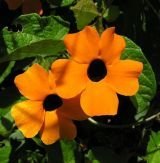Black-eyed Susan Vine
 |
Although the Black-eyed Susan Vine (Thunbergia alata) shares the same name as many Rudbeckia hirta flowers (Black & Brown-eyed Susan), this is the only relationship between the two. Rudbeckia is from the Aster and Daisy family, where this vine is from the Aeanthaceae (Acanthus) family.
|
Most vines, including this one, are not native to North America. It is important to note that this quick growing vine can become invasive given the right conditions.
Considered perennials, if grown in planting zones where frosts occur this will behave as an annual. In this case place in container and bring in over winter.
The vine starts blooming in June or July through early fall, depending on planting zones. They are:
- Good as a vine, ground cover or in hanging baskets.
- Grows in full sun, shade or partial shade.
- Likes plenty of moisture.
- Most soil types as long as they are well-drained.
- Temperatures lower than 50 degrees Fahrenheit can kill vine.
- Requires long growing season.
- Colors include red, orange, yellow and cream with dark centers
- Grows 6-8 feet tall.
|
|
 |
Other colors that Black-eyed Susan vine can be found in include:
- 'Susie Mix' - Orange, yellow and white flowers with dark centers.
- 'Alba' - White flowers and dark center.
- 'Canary Eyes' - Pale yellow with dark centers.
- 'Tiger Eyes' - Bright yellow with dark centers.
- 'Spanish Eyes - Combination of peach, rose and cream colors.
Thunbergia alata propagates by seed and stem cuttings. Start seeds indoors 6-8 weeks before last frost date or directly into soil after last frost. Germination is about 10-15 days. Because this plant is tender it's a good idea to use mulch to keep roots cool.
This is only one of many flowers that attract butterflies and many pollinators. Click to view more flowers here. Some also can invite deer into your yard. If you are having a problem with this click on the page attracting deer to get an idea of plants that you may want to stay away from.
Back from Black-eyed Susan Vine to home page
 Copyright © 2010-2022 Easy-Butterfly-Garden.com
Copyright © 2010-2022 Easy-Butterfly-Garden.com
Privacy Policy Disclaimer

Join Easy Butterfly Garden on Facebook
Recent Articles
-
Annual Bluegrass
Jan 14, 17 08:14 PM
Annual bluegrass (Poa annua) is considered a weed in the Poa family, which has a few popular turf grasses. If this gets into your butterfly garden listed are a few ways to eradicate it.
-
Candytuft Flowers
Sep 25, 16 10:54 PM
There are the annual, or Iberis, candytuft flowers and also perennials which are called Iberis sempervirens.
-
Keeping Deer Out
Sep 19, 16 01:10 PM
Reviewing the types of products available for keeping deer out of our gardens along with building fences. Many of these products help with other garden pests.
-
Butterfly Meadows
Sep 19, 16 12:52 PM
Compared to other wildlife gardening, butterfly meadows take time and are not for the faint of heart.
-
Natural Gardening
Sep 19, 16 12:32 PM
Natural gardening includes different types of gardens. These garden types create a casual, natural envirionment and help sustain native wildlife which includes butterflies.






New! Comments
Have your say about what you just read! Leave me a comment in the box below.